 |
The Saint of the Day
St. Margaret Mary Alacoque – October 17
Prof. Plinio Corrêa de Oliveira
Biographical selection:
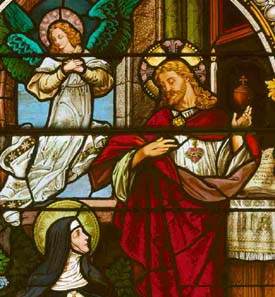
A window in Our Lady of Mount Carmel Church in Wyandotte, Michigan
|
St. Margaret Mary Alacoque (1647-1690) received revelations of the Sacred Heart of Jesus and spread this devotion.
Comments of Prof. Plinio:
There is a post-history to report about the revelations of the Sacred Heart to St. Margaret Mary that concerns our times.
You know that the Sacred Heart of Jesus appeared to St. Margaret Mary in an epoch when the revolutionary process was already well advanced. From a certain point of view, it was an irreversible process. The Middle Ages had ended, even though some remnants of the old medieval social body were still present and going forward. It was also true that the corruption of customs had entered on all fronts, and with it, the revolution of ideas. You can get a notion of the situation by studying the life of St. Louis Grignion de Montfort and some of his writings where he describes the apostasy of his times. It was a tragic picture, a precursor to the French Revolution.
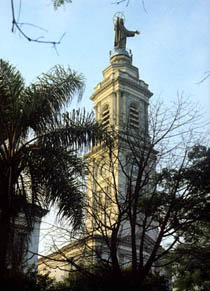
The Church of the Sacred Heart of Jesus was built in the city of Sao Paulo, Brazil, in the most prestigious neighborhood.
Above, the tower of the church;
below, the interior
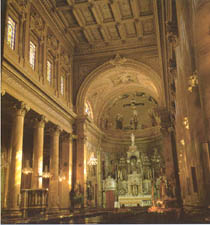
|
At that historic moment, the Sacred Heart of Jesus intervened, manifesting Himself to a religious woman of the Visitation Order, who was St. Margaret-Mary Alacoque. He told her that He was opening a new source of graces for souls, devotion to His Sacred Heart. Whoever practiced this devotion would have more abundant and generous graces than in the past. It was a way to attract souls to conversion. This devotion took root and expanded within the Church, reaching its apex in the 19th century until 1925, that is, the early pontificate of Pius XI.
This devotion has been very well studied by various theologians and great doctors, among them St. John Eudes, who promoted it vigorously. It was well-received by Popes – Leo XIII made the consecration of the world to the Sacred Heart of Jesus. Churches built in cities everywhere in the 19th and early 20th centuries were dedicated to the Sacred Heart of Jesus. It was a splendid devotion that did a great deal of good for souls.
This devotion began to be opposed on two fronts in the first years of the pontificate of Pius XI. This Modernism condemned by St. Pius X did not die, but entered a period of lethargy. Around 1924 or 1925 the same modernist heresy started to rear its head under the titles of Catholic Action and the liturgical movement. Many members of these movements started to combat devotion to the Sacred Heart in two different ways.
The first way, venomous but not the most efficient, was that in Catholic Action and liturgical milieus it began to be whispered that this devotion was sentimental and somehow effeminate, lacking theological content and acceptable only to poorly formed Catholics. If a person argued that the devotion had been approved by the Church, that St. Margaret Mary and St. John Eudes had been canonized, he would be put out of these movements. There was, therefore, a kind of defamatory campaign made against the devotion of the Sacred Heart.
Second, there was a more dangerous maneuver, which was to bury this devotion in a dense layer of silence. The devotion stopped being promoted and fell into oblivion. Churches were no longer built in honor of the Sacred Heart. The special devotions made in June, the month dedicated to the Sacred Heart, ceased to be promoted in many parishes. New devotions with suspicious theological content began to circulate.
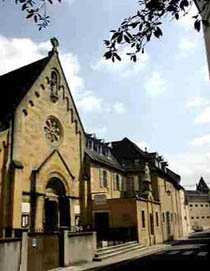
Above, the Visitation chapel and church on Paray-le-Monial
|
Today, devotion to the Sacred Heart has almost completely disappeared in the Church. Like so many others, it was put aside, another treasure to which almost no one pays attention. It is a source of graces that Divine Providence opened to save the world, and it is abandoned.
When I was in France in the late ‘50s, I went to visit Paray-le-Monial, which is where the Sacred Heart appeared to St. Margaret-Mary. In times past, it was a very popular pilgrimage site. I found it empty and abandoned; almost no one was in the church, even though it was a good season.
In the front of the church was a Catholic bookstore that should have been spreading that devotion. I went there to buy a souvenir for my mother, who was a great devotee of the Sacred Heart, and didn’t find anything worthwhile. Instead I found some very beautiful souvenir cards with phrases of Rousseau and Voltaire. The great enemies of the Church were being promoted instead of the Sacred Heart. I was profoundly shocked to find such impious things in a place established by Our Lord for the salvation of the souls. To think that ingratitude had reached such a point.
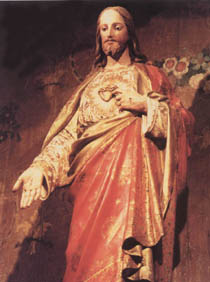
Our Lord wanted to establish devotion to His Sacred Heart to open a new source of graces for mankind
|
The fact reminded me of the invocation from the Litany of the Sacred Heart, Cor Jesu, lancea perforatum – Miserere nobis; Sacred Heart of Jesus, pierced by the lance, have mercy on us. The Heart so filled with goodness, mercy, and forgiveness, the Vessel of all possible perfections that opened Itself to men, is perforated by mankind with a lance.
This rejection of the devotion to the Sacred Heart is more blameworthy than that of the centurion who perforated the Heart of the crucified Christ, from which blood and water poured out. The centurion was partially blind and when he pierced the Heart of Our Lord with his lance, some of that water and blood fell on him and cured him, and he converted.
Today an analogous sin is being committed by the Catholic world, but there is no blood and water that cures its blindness. The blind are leading the blind, and each day they are walking further into the abyss that you know.
Let us implore the Sacred Heart of Jesus through St. Margaret Mary Alacoque that this situation end, and that both a new Christendom and a restored Holy Mother Church be reinstalled on this earth.


  | | Prof. Plinio Corrêa de Oliveira | |
The Saint of the Day features highlights from the lives of saints based on comments made by the late Prof. Plinio Corrêa de Oliveira. Following the example of St. John Bosco who used to make similar talks for the boys of his College, each evening it was Prof. Plinio’s custom to make a short commentary on the lives of the next day’s saint in a meeting for youth in order to encourage them in the practice of virtue and love for the Catholic Church. TIA thought that its readers could profit from these valuable commentaries.
The texts of both the biographical data and the comments come from personal notes taken by Atila S. Guimarães from 1964 to 1995. Given the fact that the source is a personal notebook, it is possible that at times the biographic notes transcribed here will not rigorously follow the original text read by Prof. Plinio. The commentaries have also been adapted and translated for TIA’s site.
|
Saint of the Day | Home | Books | CDs | Search | Contact Us | Donate

© 2002- Tradition in Action, Inc. All Rights Reserved
|
 |

|